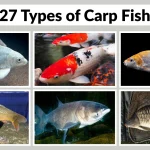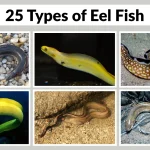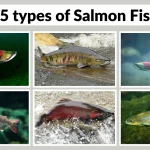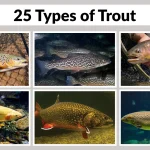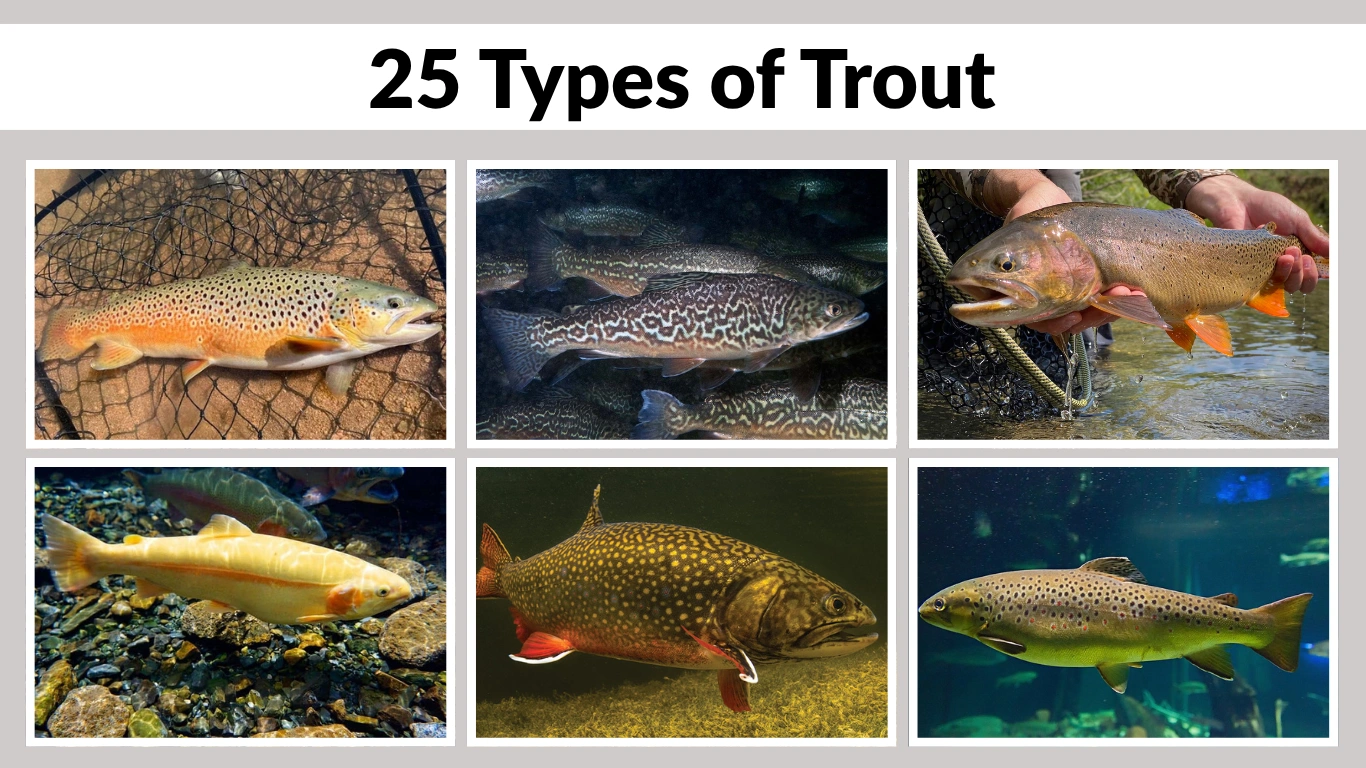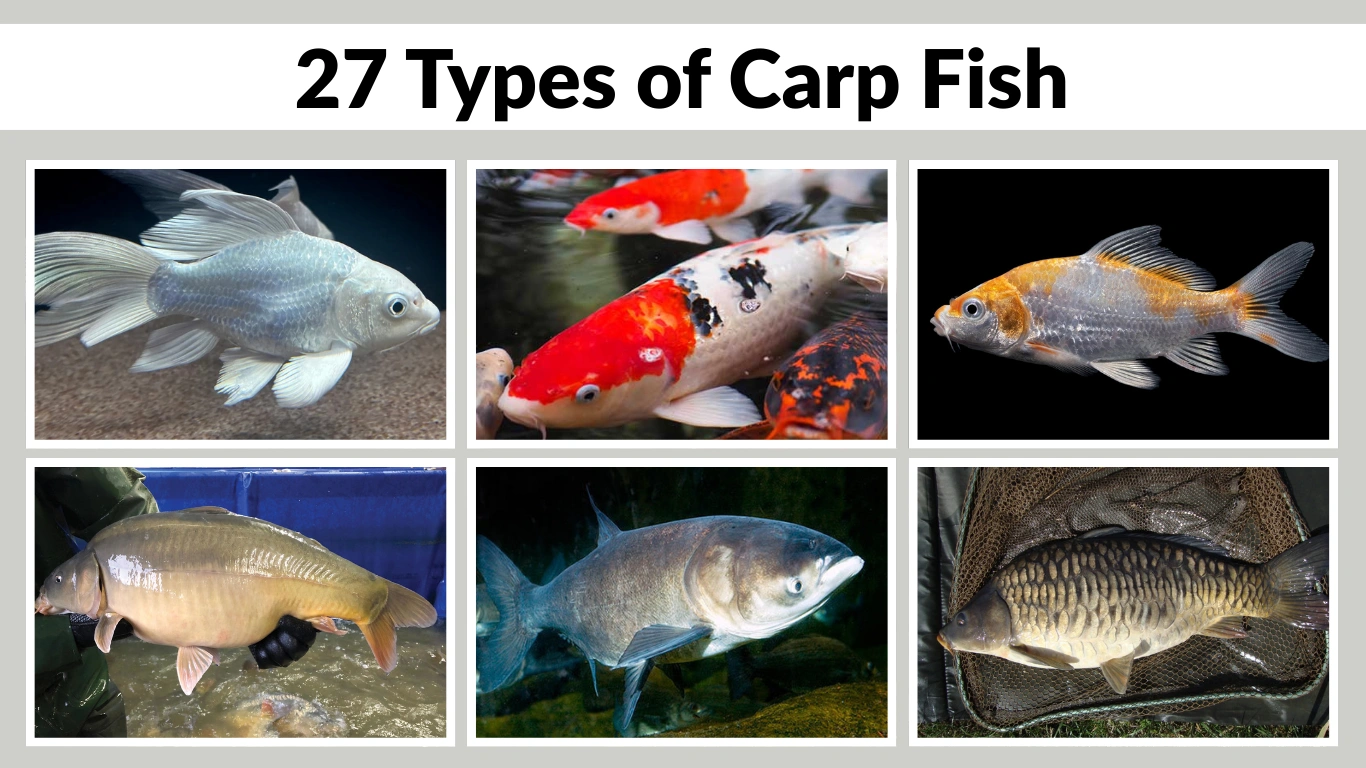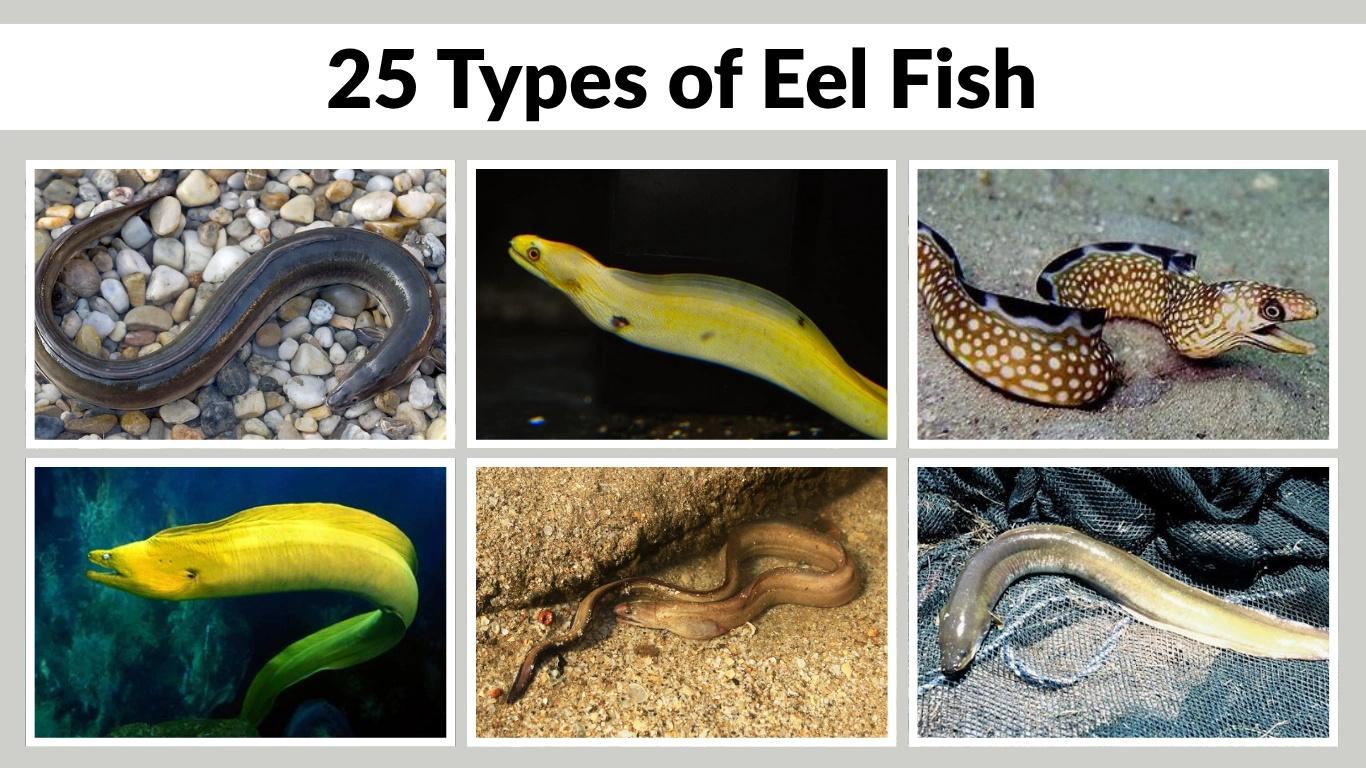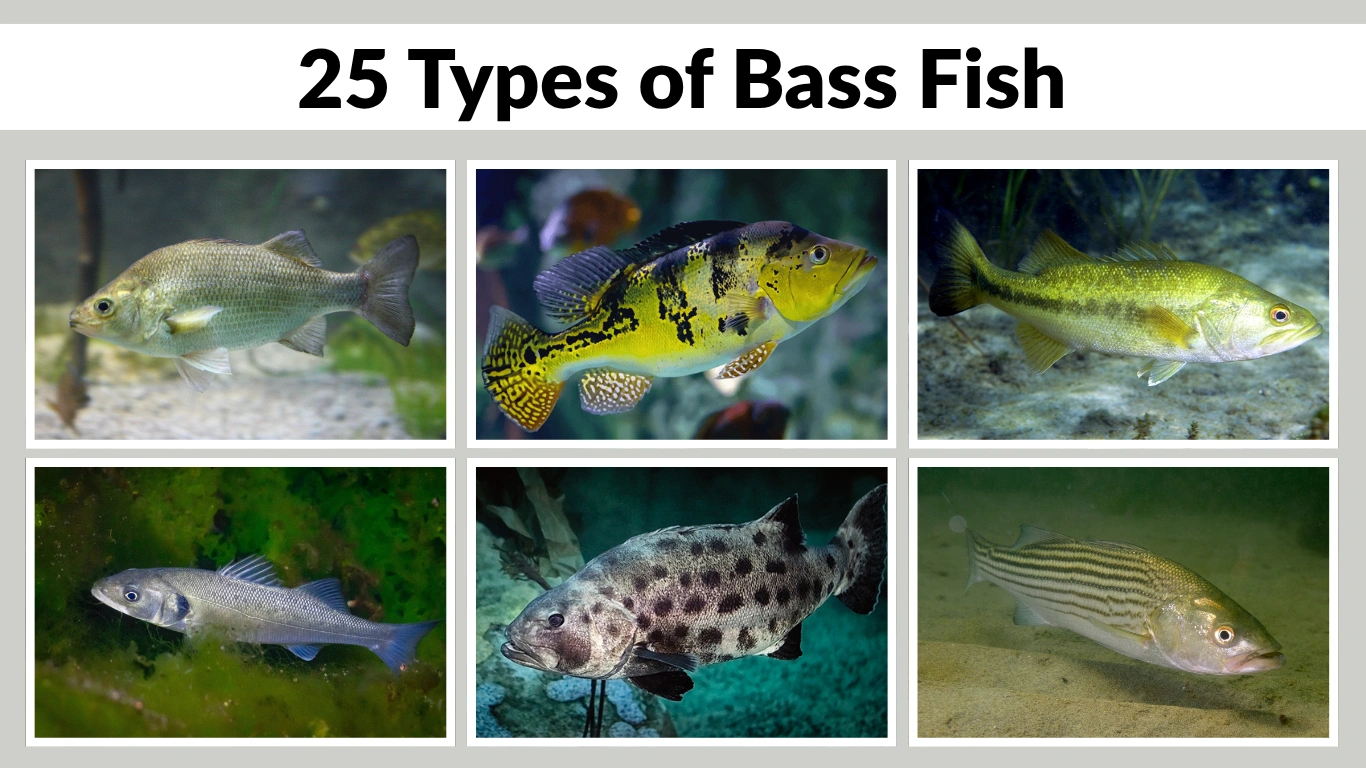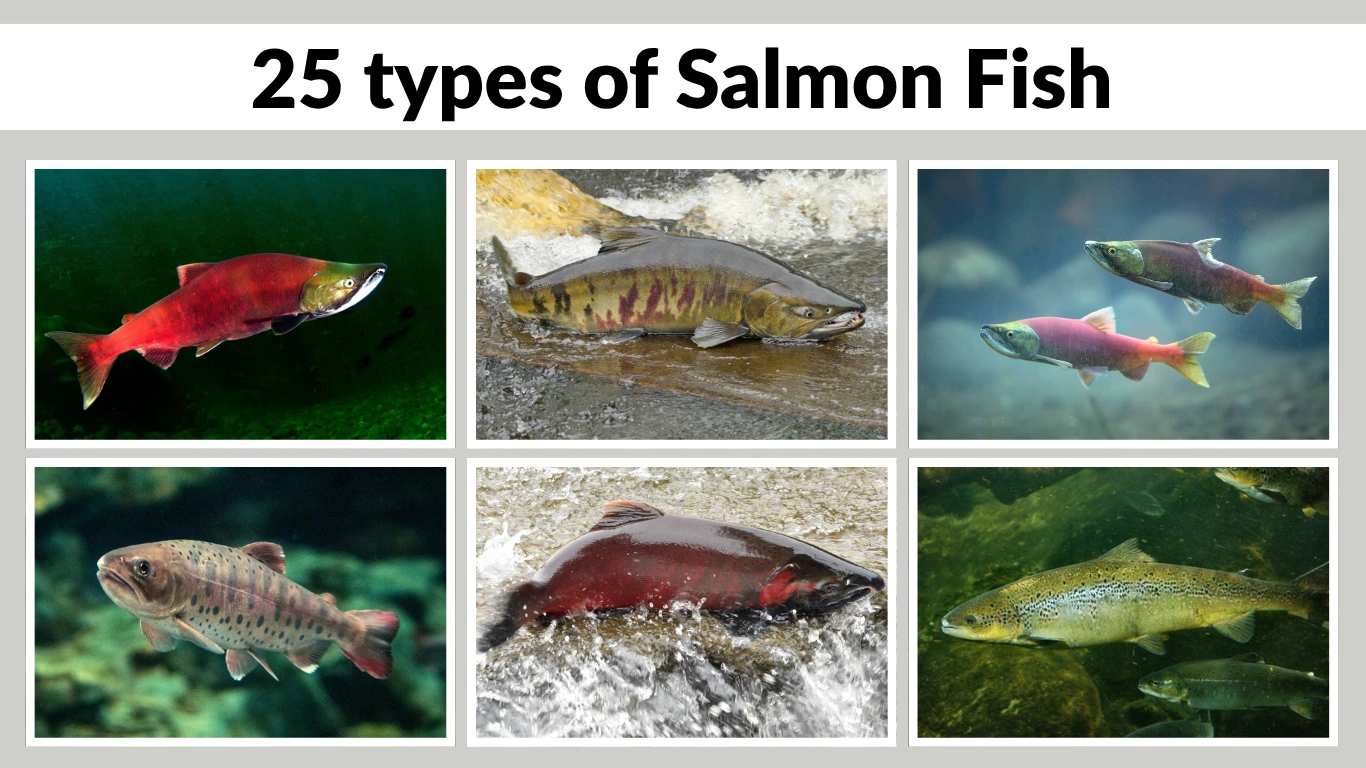Trout are a diverse group of freshwater fish prized by anglers and chefs alike for their beauty, fighting spirit, and delicious flavor. Found in cold, clear rivers and lakes worldwide, trout species range from the common rainbow trout to rare and colorful subspecies like the golden and marble trout. This guide explores 25 types of trout, highlighting their key identification features, habitats, and significance for fishing and conservation.
1. Rainbow Trout
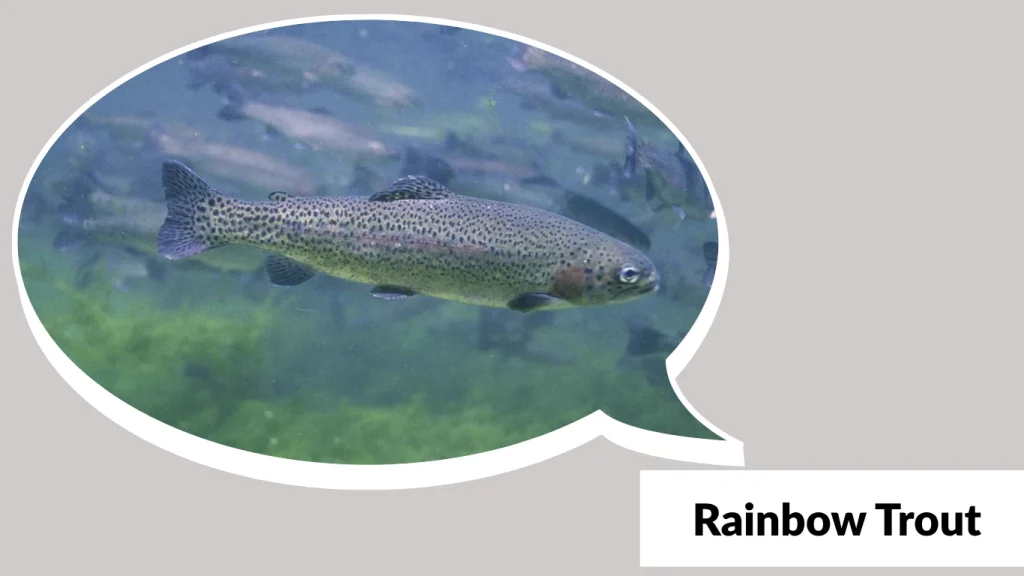
The rainbow trout is one of the most iconic freshwater fish, celebrated for its stunning coloration, adaptability, and popularity among anglers. Its vivid pink lateral stripe and speckled body make it easily recognizable, and its fighting spirit makes it a thrilling catch. In addition to being a prized game fish, it is also one of the most farmed fish species worldwide, valued for its delicate flavor and versatility in cooking.
Identification
- Scientific Name: Oncorhynchus mykiss
- Average Length: 30–60 cm (can exceed 90 cm)
- Average Weight: 1–5 kg (some over 10 kg)
- Color: Olive to bluish-green back, silvery sides with a pinkish-red lateral stripe, and black spots across body and fins
- Distinct Feature: Prominent pink stripe along the lateral line
Habitat and Distribution
Native to cold-water rivers and lakes of the Pacific coast of North America, from Alaska to Mexico. Widely introduced across Europe, South America, Asia, Africa, and Oceania due to its adaptability. Found in freshwater, and some populations (steelhead) migrate to the ocean before returning to spawn.
Diet
Opportunistic feeders consuming aquatic and terrestrial insects, crustaceans, zooplankton, fish eggs, and small fish. Diet varies seasonally and by habitat, with larger trout often being active predators.
Recreational Importance
A top target for fly fishing, bait fishing, and lure casting. Known for powerful runs, leaps, and sustained fights when hooked, making it a favorite in sport fishing tournaments.
Commercial Value
Extensively farmed in aquaculture for food markets. Its mild flavor, high nutritional value, and versatility in recipes make it a consumer favorite. Sustainable farming practices have helped maintain its availability year-round.
2. Brown Trout
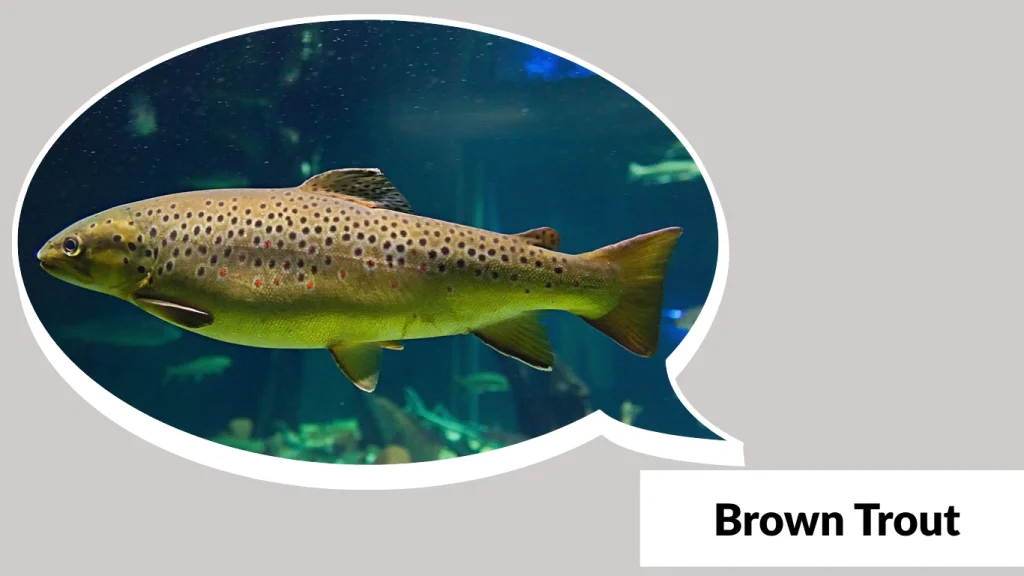
The brown trout is a highly adaptable and prized freshwater and anadromous fish, known for its elusive nature and challenging fight. Its golden-brown body with scattered black and red spots makes it one of the most visually striking trout species. Originating in Europe, it has been introduced worldwide and thrives in rivers, lakes, and coastal waters. Anglers value it for its wariness and the skill required to catch it.
Identification
- Scientific Name: Salmo trutta
- Average Length: 25–70 cm (can exceed 100 cm in large lakes)
- Average Weight: 1–14 kg depending on habitat
- Color: Golden-brown to olive, with black spots and red spots often encircled by pale halos
- Distinct Feature: Heavier build and more subdued lateral stripe compared to rainbow trout
Habitat and Distribution
Native to Europe, western Asia, and North Africa, but now widespread in North America, South America, and Oceania. Found in cold, well-oxygenated rivers, deep lakes, and coastal estuaries.
Diet
Feeds on aquatic insects, crustaceans, mollusks, and small fish. Larger specimens often become apex predators in their environment, consuming other trout and minnows.
Recreational Importance
Highly sought after for fly fishing and lure fishing due to its selective feeding habits and tendency to be more active during low light conditions.
Commercial Value
While not as heavily farmed as rainbow trout, it is harvested for niche gourmet markets, prized for its rich flavor and firm texture.
3. Brook Trout
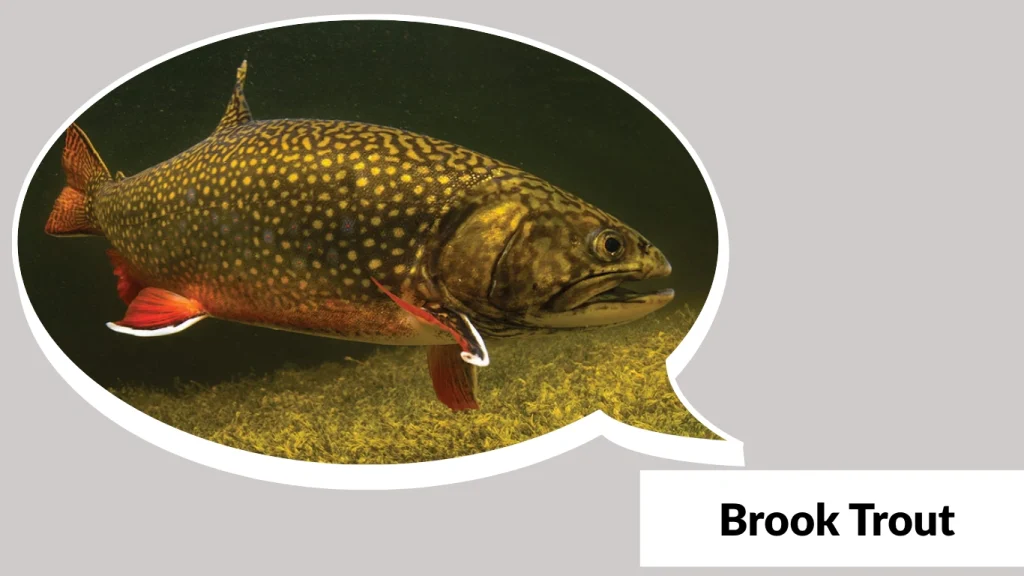
The brook trout, despite its name, is technically a char species and not a true trout. It is beloved for its stunning appearance—featuring a dark green back, worm-like marbling, and red spots surrounded by blue halos—and its presence in pristine, cold-water habitats. Often considered a symbol of unspoiled streams, it is sensitive to pollution and habitat degradation.
Identification
- Scientific Name: Salvelinus fontinalis
- Average Length: 20–50 cm
- Average Weight: 0.5–3 kg (larger in lakes)
- Color: Dark green to brown with lighter marbling (vermiculations) and red spots with blue halos
- Distinct Feature: White leading edges on the lower fins
Habitat and Distribution
Native to eastern North America, particularly in Canada and the northeastern United States. Found in cold, clear rivers, streams, and lakes, often at higher elevations.
Diet
Consumes aquatic and terrestrial insects, crustaceans, and small fish. Opportunistic feeders that adapt their diet to seasonal availability.
Recreational Importance
A favorite for fly anglers, especially in remote, scenic environments. Known for its aggressive strikes despite modest size.
Commercial Value
Occasionally farmed and stocked for sport fishing, valued for its delicate, mild flavor.
4. Lake Trout
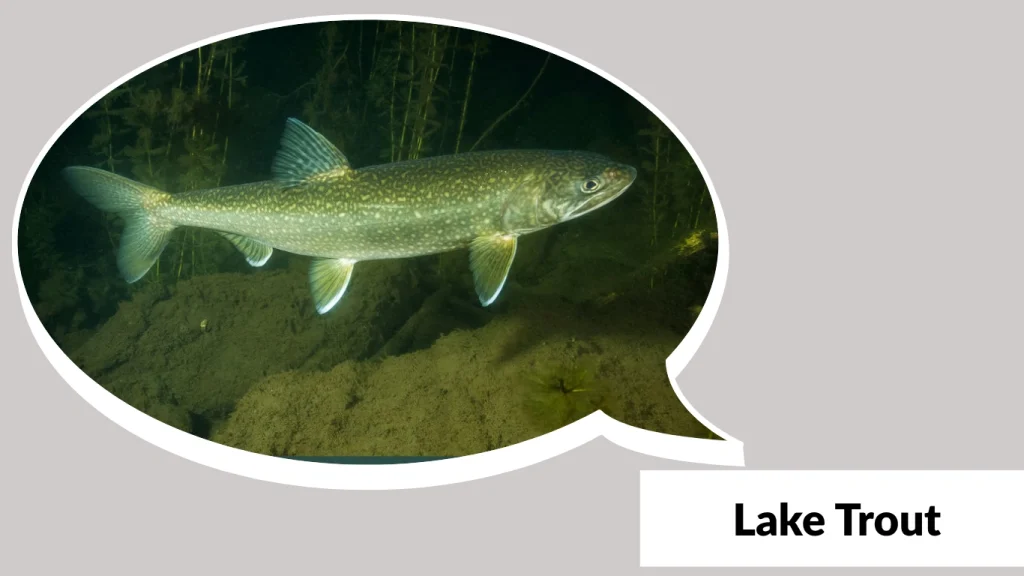
The lake trout is a large, deep-water char species known for its long lifespan and impressive size. It is a highly valued game fish in cold northern lakes and a staple in commercial freshwater fisheries. With its silvery-gray body marked by light spots, it blends perfectly into deep-water habitats. Its slow growth rate makes it vulnerable to overfishing, making sustainable management crucial.
Identification
- Scientific Name: Salvelinus namaycush
- Average Length: 50–80 cm (can exceed 120 cm)
- Average Weight: 2–15 kg, with record specimens over 30 kg
- Color: Silvery-gray to dark green with light spots covering the body and fins
- Distinct Feature: Deeply forked tail and light-colored spots on a darker background
Habitat and Distribution
Native to large, cold freshwater lakes of North America, particularly in Canada and the northern United States. Prefers deep, oxygen-rich waters.
Diet
Feeds primarily on other fish such as cisco, whitefish, and smaller trout, as well as crustaceans.
Recreational Importance
A prized trophy fish for deep-water trolling enthusiasts, known for its powerful, sustained fight.
Commercial Value
Important in commercial freshwater fisheries for its firm, oily flesh, which is excellent for smoking and grilling.
5. Cutthroat Trout

The cutthroat trout is named for the distinctive red or orange slash markings under its jaw. Known for its adaptability, it thrives in both freshwater and saltwater (anadromous) environments. Its wide range of subspecies has adapted to diverse habitats from coastal rivers to alpine lakes, making it a favorite target for anglers seeking variety.
Identification
- Scientific Name: Oncorhynchus clarkii
- Average Length: 25–80 cm
- Average Weight: 0.5–6.8 kg depending on habitat
- Color: Olive to greenish-bronze with black spots and a reddish-orange throat slash
- Distinct Feature: Prominent red or orange markings beneath the lower jaw
Habitat and Distribution
Native to western North America, from Alaska to New Mexico, including many mountain streams and rivers. Some populations migrate to the ocean before returning to spawn.
Diet
Feeds on aquatic insects, crustaceans, and small fish. In coastal forms, diet includes marine organisms.
Recreational Importance
Highly sought after for its beauty and the challenge it presents in clear, fast-flowing waters.
Commercial Value
Not heavily farmed, but stocked in many lakes and rivers to support recreational fishing.
6. Golden Trout

The golden trout is one of the most beautiful trout species, often called the “jewel of the Sierra” for its vivid golden-yellow body and bright red stripe along the sides. This high-altitude species thrives in pristine mountain streams and lakes, making it a sought-after catch for adventurous anglers willing to hike into remote wilderness areas. Its limited range and sensitivity to environmental changes make it a protected species in some areas.
Identification
- Scientific Name: Oncorhynchus aguabonita
- Average Length: 15–30 cm (rarely over 40 cm)
- Average Weight: 0.2–0.9 kg
- Color: Bright golden body with a vivid red stripe and dark spots on the back and tail
- Distinct Feature: Intense golden coloration, especially during spawning season
Habitat and Distribution
Native to the high-altitude streams of California’s Sierra Nevada mountains. Also introduced to some alpine lakes in other states and countries.
Diet
Feeds on aquatic insects, larvae, and small crustaceans, with diet varying seasonally.
Recreational Importance
A prized target for fly fishers due to its rarity, beauty, and the remote locations where it’s found.
Commercial Value
Not commercially farmed, primarily valued for sport fishing and conservation purposes.
7. Bull Trout

The bull trout is a large, predatory char species known for its impressive size, cold-water habitat, and role as an indicator species for pristine ecosystems. It has a robust, elongated body with pale yellow to reddish spots and no black spots on the dorsal fin—an important distinguishing feature. Once widespread in North America’s northwest, its range has declined due to habitat loss and overfishing, leading to protective regulations in many areas.
Identification
- Scientific Name: Salvelinus confluentus
- Average Length: 60–90 cm (can exceed 100 cm)
- Average Weight: 2–10 kg, with trophy specimens over 14 kg
- Color: Olive-green to brown with light-colored spots; belly lighter, sometimes orange-tinted
- Distinct Feature: Lack of black spots on the dorsal fin, unlike other trout species
Habitat and Distribution
Native to the Pacific Northwest, from northern California to Alaska, and inland waters of the Rocky Mountains. Found in deep, cold rivers, lakes, and headwater streams. Migratory forms move between large lakes or the ocean and rivers to spawn.
Diet
Primarily piscivorous, feeding on other fish such as salmon smolts, whitefish, and minnows. Juveniles feed on aquatic insects before shifting to a fish-based diet.
Recreational Importance
Valued for its size, strength, and challenge, but strictly regulated—often catch-and-release only in many regions.
Conservation Status
Listed as a threatened species under the U.S. Endangered Species Act, with habitat restoration and fishing restrictions in place to aid recovery.
8. Apache Trout

The Apache trout is a rare and beautiful trout species, notable for being one of only two trout species native to Arizona. It features a golden-yellow body, small dark spots evenly distributed over the body and fins, and a distinctive black stripe through the eye. Once near extinction, it has been successfully reintroduced in parts of its historical range through conservation efforts.
Identification
- Scientific Name: Oncorhynchus apache
- Average Length: 25–60 cm
- Average Weight: 0.5–2.5 kg
- Color: Yellow-gold with black spots and a subtle pinkish lateral blush
- Distinct Feature: Narrow black stripe through the eye, giving it a unique facial marking
Habitat and Distribution
Native to the cold, clear headwater streams of Arizona’s White Mountains. Restricted to specific watersheds due to historical habitat loss.
Diet
Feeds on aquatic insects, small crustaceans, and occasionally small fish. Diet is influenced by seasonal availability of prey in mountain streams.
Recreational Importance
Highly sought after by anglers for its rarity and beauty. Often pursued as part of the “Arizona trout slam” challenge.
Conservation Status
Listed as a threatened species, with ongoing habitat restoration, non-native fish removal, and stocking programs supporting its survival.
9. Gila Trout

The Gila trout is a rare, golden-hued trout species native to the mountainous streams of New Mexico and Arizona. It is closely related to the Apache trout but has a more intense yellow-gold coloration and fewer, smaller spots. Once pushed to the brink of extinction due to overfishing, habitat loss, and competition from non-native trout, it has made a significant comeback through conservation and restocking programs.
Identification
- Scientific Name: Oncorhynchus gilae
- Average Length: 25–45 cm (occasionally up to 55 cm)
- Average Weight: 0.5–1.5 kg
- Color: Bright golden-yellow body with small dark spots mainly above the lateral line
- Distinct Feature: Reduced spotting on lower body, golden coloration more intense than Apache trout
Habitat and Distribution
Native to cool, high-altitude streams of the Gila River basin in New Mexico and Arizona. Prefers clear, cold, well-oxygenated waters in mountainous areas.
Diet
Feeds on aquatic insects, mayflies, caddisflies, and terrestrial insects that fall into the water. Larger individuals may consume small fish.
Recreational Importance
Highly prized by anglers due to its rarity and beauty, often sought as part of special trout challenges in the Southwest.
Conservation Status
Federally listed as threatened, with habitat restoration, non-native species removal, and stocking programs aiding its recovery.
10. Tiger Trout

The tiger trout is a striking hybrid species created by crossing a female brown trout (Salmo trutta) with a male brook trout (Salvelinus fontinalis). It is sterile, meaning it cannot reproduce, which makes it easier to manage in stocked fisheries. Its name comes from the distinctive dark, maze-like markings across its body that resemble a tiger’s stripes.
Identification
- Scientific Name: Hybrid of Salmo trutta × Salvelinus fontinalis
- Average Length: 30–60 cm
- Average Weight: 1–4 kg (trophy fish over 6 kg)
- Color: Olive to golden-brown with intricate black worm-like markings and lighter underbelly
- Distinct Feature: Unique vermiculated “tiger stripe” pattern covering body
Habitat and Distribution
Not naturally occurring; produced in hatcheries and stocked in lakes and rivers across North America, Europe, and parts of Oceania. Prefers cold, well-oxygenated waters.
Diet
Voracious predators feeding on smaller fish, insects, and crustaceans. Known for their aggressive feeding behavior.
Recreational Importance
Popular among anglers for their beauty, rarity, and aggressive strikes, often considered more challenging to catch than other trout.
Management Purpose
Stocked for sport fishing and to control populations of invasive baitfish in certain fisheries.
11. Palomino Trout

The palomino trout is a vibrant, golden-colored variant of the rainbow trout, prized for its striking appearance. This trout’s unique coloration—ranging from bright yellow to deep gold—makes it highly sought after both by anglers and ornamental fish enthusiasts. It is often stocked in fishing lakes and ponds to enhance aesthetic appeal and provide an exciting fishing experience.
Identification
- Scientific Name: Oncorhynchus mykiss (color variant)
- Average Length: 30–50 cm
- Average Weight: 0.5–2.5 kg
- Color: Bright golden-yellow body with a faint pink lateral stripe and black spots
- Distinct Feature: Distinctive golden coloration setting it apart from typical rainbow trout
Habitat and Distribution
Primarily found in stocked freshwater lakes, ponds, and reservoirs across North America and other regions where rainbow trout are cultivated.
Diet
Feeds on aquatic insects, small fish, and crustaceans, similar to other rainbow trout varieties.
Recreational Importance
Highly popular in recreational fisheries due to its attractive color and strong fighting ability, often used to diversify fishery offerings.
Commercial Value
Commonly bred in hatcheries for stocking purposes, contributing to both sport fishing and ornamental fish markets.
12. Steelhead Trout

The steelhead trout is the anadromous, or sea-run, form of the rainbow trout. Unlike their freshwater counterparts, steelhead migrate to the ocean where they grow larger before returning to freshwater streams to spawn. Known for their incredible endurance and powerful runs, steelhead are among the most prized game fish for anglers worldwide.
Identification
- Scientific Name: Oncorhynchus mykiss
- Average Length: 50–100 cm
- Average Weight: 3–11 kg
- Color: Silvery body with a broad pink or red stripe along the lateral line and small black spots
- Distinct Feature: Streamlined body adapted for long-distance migration
Habitat and Distribution
Native to Pacific coastal rivers of North America and Asia, migrating between freshwater spawning grounds and ocean feeding areas.
Diet
Ocean phase diet includes small fish, squid, and crustaceans; freshwater juveniles feed on insects and plankton.
Recreational Importance
Highly valued by sport fishers for their size, fighting ability, and the challenge of catching them during spawning runs.
Conservation Status
Many populations are threatened due to habitat loss and overfishing, prompting conservation and hatchery programs.
13. Splake
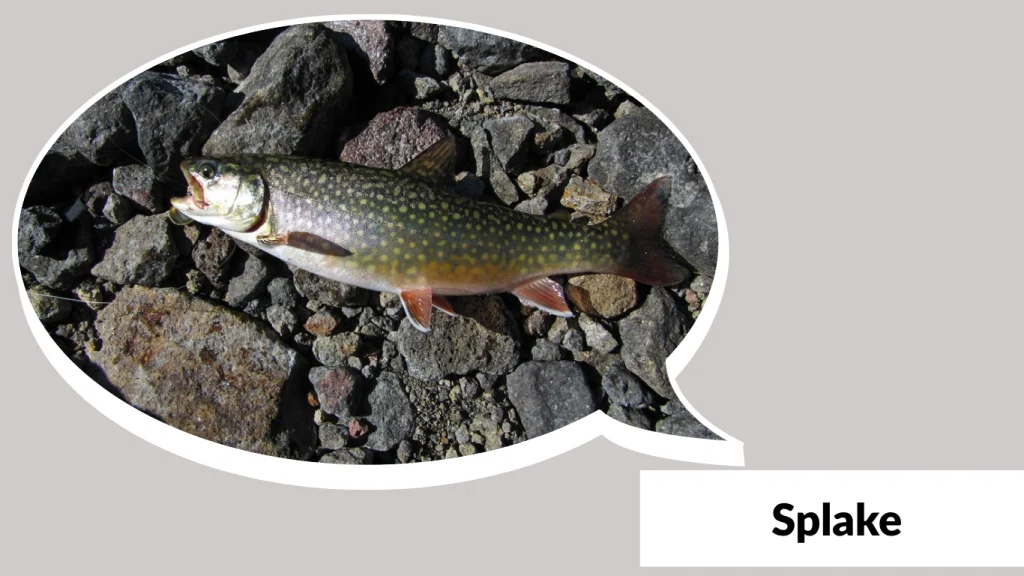
The splake is a hybrid trout species resulting from the cross between a male brook trout (Salvelinus fontinalis) and a female lake trout (Salvelinus namaycush). This sterile hybrid combines traits of both parents, including fast growth rates and adaptability, making it popular for stocking in lakes where natural reproduction is challenging.
Identification
- Scientific Name: Hybrid of Salvelinus fontinalis × Salvelinus namaycush
- Average Length: 30–60 cm
- Average Weight: 1–5 kg
- Color: Body pattern varies but often has spots like brook trout with a more streamlined shape resembling lake trout
- Distinct Feature: Hybrid physical traits combining brook trout coloration with lake trout size and shape
Habitat and Distribution
Commonly stocked in North American lakes, especially where native lake trout populations are limited or where fishing pressure is high.
Diet
Feeds on a variety of prey including insects, crustaceans, and smaller fish, displaying aggressive predatory behavior.
Recreational Importance
Favored by anglers for its fighting ability and adaptability to cold, deep-water environments.
Management Purpose
Stocked to improve fishery opportunities, especially in lakes lacking natural reproduction or where native species are vulnerable.
14. Dolly Varden

The Dolly Varden is a char species closely related to trout, known for its beautiful coloration and adaptability to cold northern waters. It inhabits both freshwater and anadromous populations, with migratory forms traveling between the ocean and inland streams. Its striking pattern of light spots on a dark body makes it easily distinguishable.
Identification
- Scientific Name: Salvelinus malma
- Average Length: 30–70 cm
- Average Weight: 1–5 kg
- Color: Dark green to brown with pale yellow or orange spots
- Distinct Feature: Light spots evenly distributed over body and fins
Habitat and Distribution
Native to cold waters of Alaska, Canada, and northern Asia. Found in rivers, lakes, and coastal areas with migratory and resident populations.
Diet
Feeds on aquatic insects, crustaceans, and small fish, with larger individuals often preying on juvenile salmon and other trout.
Recreational Importance
Valued for sport fishing, especially in remote northern locations. Known for its strong fight and beautiful appearance.
Conservation Status
Generally stable but affected locally by habitat degradation and overfishing.
15. Marble Trout
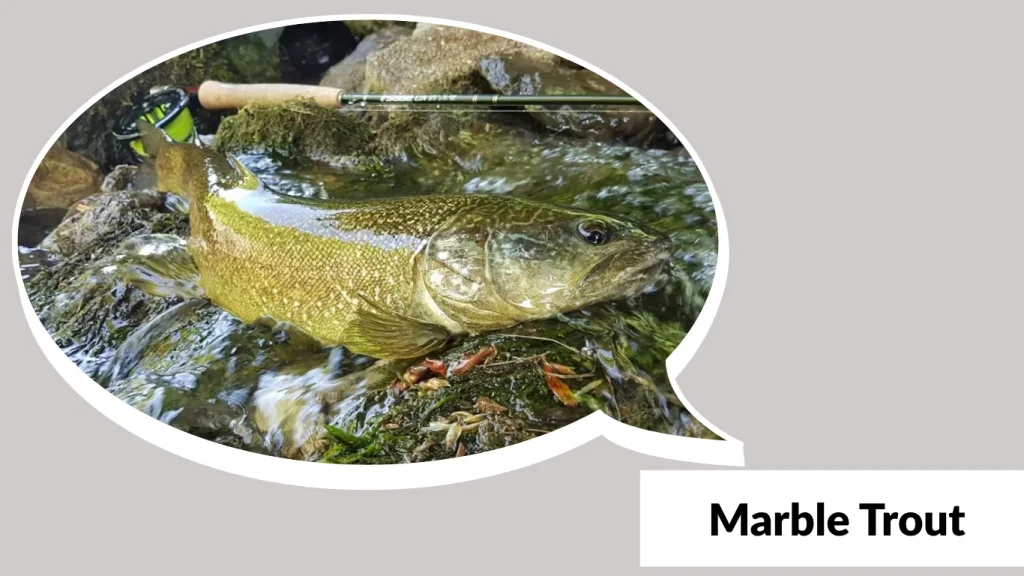
The marble trout is a rare and striking trout species native to the rivers of the Balkans. It is named for its distinctive marbled pattern of dark swirling markings across a lighter golden-brown body. Highly prized by anglers for its beauty and elusive nature, it inhabits fast-flowing, cold mountain streams and rivers.
Identification
- Scientific Name: Salmo marmoratus
- Average Length: 40–80 cm
- Average Weight: 1–5 kg
- Color: Golden to brown with prominent dark marbled or mottled patterns
- Distinct Feature: Unique marbled coloration resembling a stone pattern
Habitat and Distribution
Native to river systems in Slovenia, Croatia, Bosnia and Herzegovina, and surrounding Balkan countries. Prefers clean, well-oxygenated cold waters.
Diet
Feeds primarily on aquatic insects, small fish, and crustaceans, adapting to available prey in mountain streams.
Recreational Importance
Highly sought after by fly fishers for its fighting ability and rarity.
Conservation Status
Threatened by habitat loss, hybridization with introduced trout species, and water pollution.
16. Sevan Trout
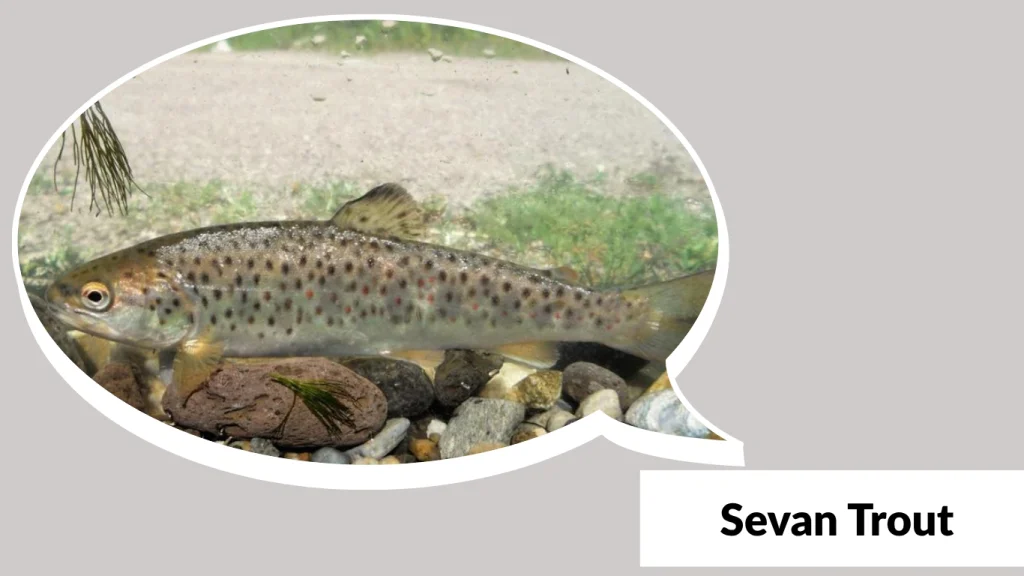
The Sevan trout is a unique species endemic to Lake Sevan in Armenia. It is notable for its importance in local fisheries and cultural significance. The species exhibits diverse life strategies, with both resident and migratory populations adapting to different lake and river environments.
Identification
- Scientific Name: Salmo ischchan
- Average Length: 40–80 cm
- Average Weight: 2–6 kg
- Color: Silver to bronze with small scattered spots, sometimes with faint vertical bars
- Distinct Feature: Adapted to large lake environments with a streamlined body
Habitat and Distribution
Found exclusively in Lake Sevan and its tributaries in Armenia, inhabiting deep, cold waters.
Diet
Feeds on smaller fish, plankton, and aquatic invertebrates, depending on life stage and habitat.
Recreational Importance
Important for local commercial and sport fisheries, prized for its size and flavor.
Conservation Status
Listed as endangered due to overfishing, habitat degradation, and introduction of invasive species.
17. Ohrid Trout

The Ohrid trout is a rare and endemic trout species native to Lake Ohrid, which straddles the border between North Macedonia and Albania. This trout is renowned for its exceptional size and unique genetic characteristics. It plays a vital ecological and economic role in the region, being a primary target for local fisheries and an important species for biodiversity.
Identification
- Scientific Name: Salmo letnica
- Average Length: 40–70 cm
- Average Weight: 2–6 kg
- Color: Silvery body with dark spots concentrated near the dorsal area
- Distinct Feature: Robust body with fewer spots compared to other trout species
Habitat and Distribution
Confined to Lake Ohrid and its tributaries, the fish prefers deep, cold, oxygen-rich waters but spawns in tributary streams.
Diet
Feeds on smaller fish, aquatic insects, and plankton, with diet varying seasonally and by habitat.
Recreational Importance
A prized game fish locally, it attracts anglers from across Europe.
Conservation Status
Vulnerable due to overfishing, habitat changes, and competition with introduced species, leading to conservation efforts.
18. Kamloops Rainbow Trout

The Kamloops rainbow trout is a subspecies or strain of rainbow trout known for its large size and vibrant coloration. Native to certain rivers and lakes in British Columbia, Canada, it is highly prized by anglers and often stocked in fisheries for sport fishing. Kamloops trout exhibit strong fighting ability and aggressive feeding behavior.
Identification
- Scientific Name: Oncorhynchus mykiss kamloops
- Average Length: 40–70 cm
- Average Weight: 1.5–7 kg
- Color: Bright iridescent blue-green back, silver sides with a prominent pink to red lateral stripe
- Distinct Feature: Larger size and more intense coloration compared to other rainbow trout strains
Habitat and Distribution
Native to British Columbia’s interior lakes and rivers but widely introduced elsewhere. Prefers cold, clear waters with gravelly spawning grounds.
Diet
Feeds on aquatic insects, small fish, and crustaceans, showing aggressive predation especially in stocked environments.
Recreational Importance
Highly sought after for trophy fishing due to its size, color, and fighting capabilities.
Commercial Value
Stocked extensively in recreational fisheries, contributing significantly to local economies through angling tourism.
19. Coastal Cutthroat Trout

The coastal cutthroat trout is a subspecies of cutthroat trout that inhabits coastal rivers and streams along the Pacific Northwest of North America. Unlike some other cutthroat subspecies, it frequently migrates between freshwater and estuarine environments. Known for its vibrant coloration and distinctive red or orange throat slashes, it is a prized species among anglers and conservationists alike.
Identification
- Scientific Name: Oncorhynchus clarkii clarkii
- Average Length: 30–70 cm
- Average Weight: 0.5–5 kg
- Color: Olive-green to brown back, silver sides with bright red or orange throat slashes and black spots
- Distinct Feature: Bright throat slashes and spotted body extending onto fins
Habitat and Distribution
Found in coastal rivers from northern California to Alaska, often inhabiting estuaries and lower river reaches, with some populations being fully freshwater resident.
Diet
Feeds on aquatic insects, small fish, and crustaceans, with diet changing seasonally and by habitat.
Recreational Importance
Popular among fly fishers and sport anglers for its fighting ability and scenic habitats.
Conservation Status
Certain populations are threatened by habitat loss, barriers to migration, and competition with non-native species, prompting restoration efforts.
20. Yellowstone Cutthroat Trout
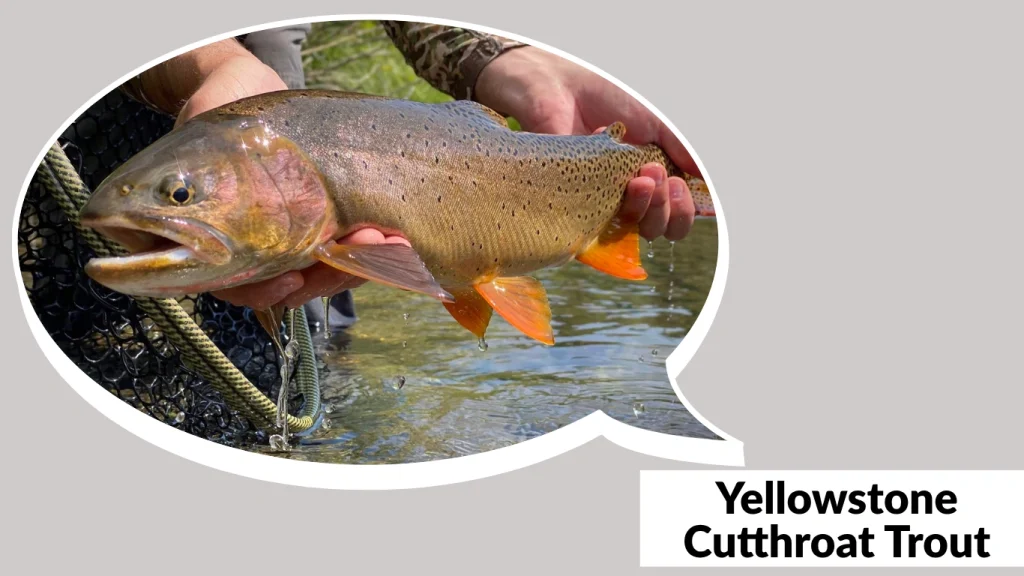
The Yellowstone cutthroat trout is native to the Yellowstone River basin in the United States. It is known for its orange to red coloration along the jaw and distinctive black spots, making it visually distinctive. This subspecies prefers clear, cold mountain streams and lakes, playing an important ecological role in its native range.
Identification
- Scientific Name: Oncorhynchus clarkii bouvieri
- Average Length: 25–60 cm
- Average Weight: 0.5–3.5 kg
- Color: Olive to golden with numerous black spots and orange-red markings on the jaw
- Distinct Feature: Orange to red coloration beneath the lower jaw and numerous black spots
Habitat and Distribution
Native to the Yellowstone River and tributaries across Wyoming, Montana, and Idaho, favoring clear, cold waters at higher elevations.
Diet
Feeds on aquatic insects, crustaceans, and small fish, with seasonal shifts in prey availability.
Recreational Importance
Highly regarded by anglers for its beauty and willingness to strike flies and lures, often caught in scenic wilderness areas.
Conservation Status
Populations face threats from hybridization with non-native rainbow trout and habitat alterations, leading to active management and conservation programs.
21. Bonneville Cutthroat Trout

The Bonneville cutthroat trout is native to the Bonneville Basin region, including parts of Utah, Idaho, and Nevada. Known for its distinctive orange-red slash beneath the jaw and numerous dark spots, it inhabits cold, clear mountain streams, rivers, and lakes. This subspecies has cultural and ecological importance in its native range.
Identification
- Scientific Name: Oncorhynchus clarkii utah
- Average Length: 25–55 cm
- Average Weight: 0.5–3 kg
- Color: Olive to brown with black spots concentrated on the back and dorsal fin; orange-red markings on the throat
- Distinct Feature: Bright throat slashes with dense spotting patterns
Habitat and Distribution
Found mainly in the Bonneville Basin and surrounding watersheds, including streams, rivers, and lakes at various elevations.
Diet
Feeds on aquatic insects, small fish, and crustaceans, adapting diet seasonally depending on availability.
Recreational Importance
Popular among anglers for its challenging fight and scenic habitats, often targeted with fly fishing techniques.
Conservation Status
Considered a species of concern due to habitat loss, water diversion, and competition with non-native trout species, with ongoing restoration efforts.
22. Lahontan Cutthroat Trout

The Lahontan cutthroat trout is the largest subspecies of cutthroat trout, capable of reaching impressive sizes in the deep lakes and rivers of the Lahontan Basin. Recognized for its golden hue and distinctive spotting, it is a symbol of the region’s aquatic biodiversity and an important species for native fisheries.
Identification
- Scientific Name: Oncorhynchus clarkii henshawi
- Average Length: 40–90 cm
- Average Weight: 1.5–10 kg
- Color: Golden-yellow to bronze with scattered black spots, especially on the back and dorsal fin
- Distinct Feature: Large size and broad body with distinctive golden coloration
Habitat and Distribution
Native to the Lahontan Basin covering parts of Nevada, California, and Oregon, inhabiting lakes, reservoirs, and connected river systems.
Diet
Feeds on a variety of aquatic insects, crustaceans, and smaller fish, including sculpins and minnows.
Recreational Importance
Highly sought after by anglers for trophy fishing opportunities in western U.S. waters.
Conservation Status
Historically overfished and impacted by habitat changes, now the focus of active conservation and restocking programs.
23. Paiute Cutthroat Trout
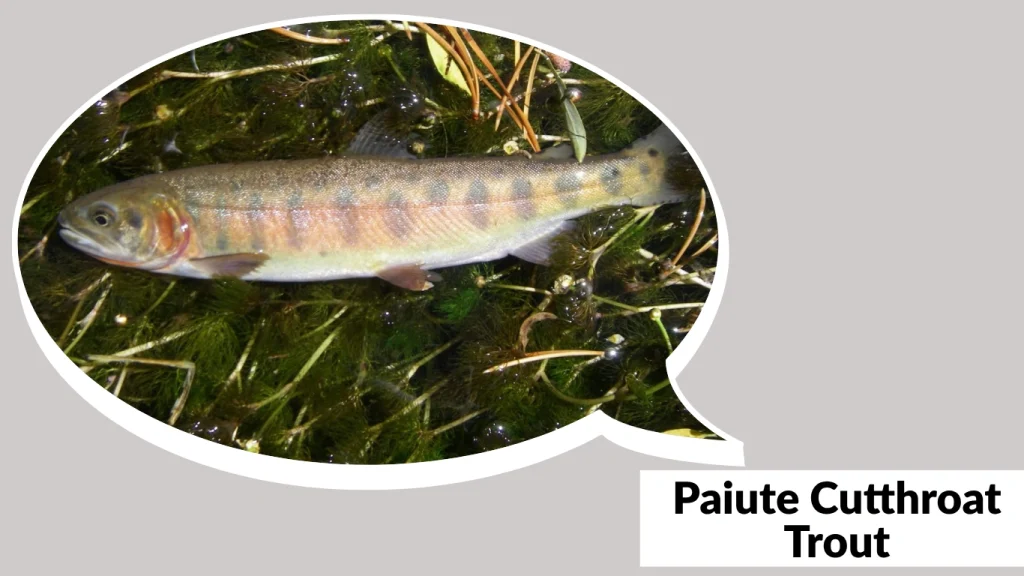
The Paiute cutthroat trout is one of the rarest trout subspecies, known for its pale coloration and limited native range. It exhibits faint spotting and a streamlined body adapted to the clear, cold mountain streams of eastern California. Conservation efforts have been crucial in protecting this trout from extinction due to its highly restricted habitat.
Identification
- Scientific Name: Oncorhynchus clarkii seleniris
- Average Length: 25–45 cm
- Average Weight: 0.3–1.5 kg
- Color: Light silver to pale gold with sparse black spots mainly near the tail
- Distinct Feature: Pale coloration and minimal spotting compared to other cutthroat subspecies
Habitat and Distribution
Native exclusively to tributaries of the East Fork Carson River in the Sierra Nevada mountains, California. Prefers cold, clear, fast-flowing streams.
Diet
Feeds on aquatic insects, larvae, and small crustaceans. Seasonal diet variations depend on prey availability.
Recreational Importance
Due to its rarity and limited distribution, it is primarily of conservation interest rather than a common sport fish.
Conservation Status
Listed as endangered; ongoing habitat protection, non-native species removal, and breeding programs support its survival.
24. Redband Trout

The redband trout is a hardy subspecies of rainbow trout adapted to the variable and often harsh conditions of interior western North America. It is characterized by its distinct red lateral stripe and spotted body. Known for its resilience, it inhabits a range of waters from small streams to larger rivers.
Identification
- Scientific Name: Oncorhynchus mykiss gairdneri
- Average Length: 25–50 cm
- Average Weight: 0.5–3 kg
- Color: Olive to dark green back, red to orange lateral stripe, and dark spots on body and fins
- Distinct Feature: Bright red stripe along the lateral line with dense spotting
Habitat and Distribution
Native to the interior Columbia River Basin and surrounding regions in the western United States and Canada. Prefers small streams and mid-sized rivers with variable flows.
Diet
Feeds on aquatic insects, small fish, and crustaceans, adapting diet based on seasonal and habitat conditions.
Recreational Importance
Popular among fly fishers for its aggressive behavior and adaptability to diverse habitats.
Conservation Status
Generally stable but threatened locally by habitat degradation and hybridization with introduced rainbow trout strains.
25. Leopard Rainbow Trout

The leopard rainbow trout is a distinctive color variant of the rainbow trout, named for its unique pattern of large, dark spots that resemble a leopard’s coat. This striking pattern makes it a favorite among anglers and aquarists looking for visually impressive fish. It shares the same general behavior and habitat preferences as other rainbow trout varieties.
Identification
- Scientific Name: Oncorhynchus mykiss (color variant)
- Average Length: 30–60 cm
- Average Weight: 0.5–3 kg
- Color: Silvery body with large, irregular dark spots covering the back, sides, and fins
- Distinct Feature: Prominent leopard-like spot pattern distinctly different from typical rainbow trout spots
Habitat and Distribution
Found in stocked freshwater lakes and rivers worldwide, especially in recreational fisheries and private ponds.
Diet
Feeds on aquatic insects, small fish, and crustaceans, similar to other rainbow trout varieties.
Recreational Importance
Valued for its unique appearance and strong fight, making it a popular trophy fish in sport fishing.
Commercial Value
Bred in hatcheries primarily for ornamental purposes and stocked recreational fisheries.

